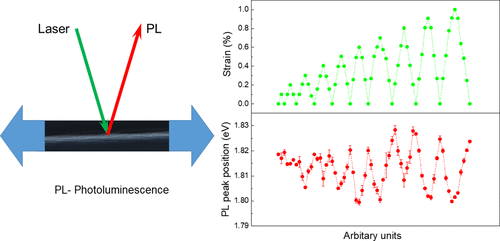当前位置:
X-MOL 学术
›
ACS Appl. Nano Mater.
›
论文详情
Our official English website, www.x-mol.net, welcomes your
feedback! (Note: you will need to create a separate account there.)
MoS2 Nanosheet-Coated Carbon Fibers as Strain Sensors in Epoxy Composites
ACS Applied Nano Materials ( IF 5.3 ) Pub Date : 2021-09-08 , DOI: 10.1021/acsanm.1c01723 Jingwen Chu 1, 2 , Mark A. Bissett 1 , Robert J. Young 1
ACS Applied Nano Materials ( IF 5.3 ) Pub Date : 2021-09-08 , DOI: 10.1021/acsanm.1c01723 Jingwen Chu 1, 2 , Mark A. Bissett 1 , Robert J. Young 1
Affiliation

|
Recent decades have witnessed the massive growth of interest in two-dimensional (2D) nanomaterials. Molybdenum disulfide (MoS2) is one of the most attractive members of the 2D nanomaterial family, as it is semiconducting with a tunable band gap. Previous studies on the use of graphene as a strain sensor show the potential of 2D materials in composite-related applications. Compared with graphene, monolayer MoS2 has an intensive photoluminescence (PL) peak, which shows a large strain-induced shift, making it a preferential candidate as a strain indicator. In this study, we coated MoS2 grown by chemical vapor deposition (CVD) onto the surface of individual carbon fibers to act as strain indicators in a fiber/epoxy model composite, based on the strain-induced PL peak shift. It is demonstrated that the strain sensing ability of the coated MoS2 is highly reproducible during more than 10 cycles of deformation to ∼0.4% tensile strain without significant interfacial damage. The local fiber strain can be detected by the coated MoS2 under deformations up to ∼0.8% matrix strain, which is higher than that of CVD graphene reported previously. In addition, strain reporting along a coated fiber in the model composite can be achieved, from which the strain distribution along the fiber and the stress transfer at the interface can be investigated. This study shows the potential of MoS2 enabled by photoluminescence spectroscopy serving as a viable nanoscale strain sensor, which can be employed in fiber-reinforced composites to monitor local strain over a structure on the microscale.
中文翻译:

MoS2 纳米片涂层碳纤维作为环氧树脂复合材料中的应变传感器
近几十年来,人们对二维 (2D) 纳米材料的兴趣大幅增长。二硫化钼 (MoS 2 ) 是二维纳米材料家族中最具吸引力的成员之一,因为它是具有可调带隙的半导体。先前关于使用石墨烯作为应变传感器的研究显示了二维材料在复合材料相关应用中的潜力。与石墨烯相比,单层MoS 2具有强烈的光致发光(PL)峰,显示出较大的应变引起的位移,使其成为应变指示剂的首选候选者。在这项研究中,我们涂覆了 MoS 2基于应变诱导的 PL 峰位移,通过化学气相沉积 (CVD) 在单个碳纤维的表面上生长,作为纤维/环氧树脂模型复合材料中的应变指示器。结果表明,涂层MoS 2的应变传感能力在超过 10 次变形循环至约 0.4% 拉伸应变期间具有高度可再现性,而不会造成显着的界面损伤。可以通过涂覆的 MoS 2检测局部纤维应变在变形高达 0.8% 的基体应变下,这高于之前报道的 CVD 石墨烯。此外,可以实现模型复合材料中沿涂层纤维的应变报告,从中可以研究沿纤维的应变分布和界面处的应力传递。该研究显示了通过光致发光光谱实现的 MoS 2作为可行的纳米级应变传感器的潜力,该传感器可用于纤维增强复合材料以在微观尺度上监测结构上的局部应变。
更新日期:2021-09-24
中文翻译:

MoS2 纳米片涂层碳纤维作为环氧树脂复合材料中的应变传感器
近几十年来,人们对二维 (2D) 纳米材料的兴趣大幅增长。二硫化钼 (MoS 2 ) 是二维纳米材料家族中最具吸引力的成员之一,因为它是具有可调带隙的半导体。先前关于使用石墨烯作为应变传感器的研究显示了二维材料在复合材料相关应用中的潜力。与石墨烯相比,单层MoS 2具有强烈的光致发光(PL)峰,显示出较大的应变引起的位移,使其成为应变指示剂的首选候选者。在这项研究中,我们涂覆了 MoS 2基于应变诱导的 PL 峰位移,通过化学气相沉积 (CVD) 在单个碳纤维的表面上生长,作为纤维/环氧树脂模型复合材料中的应变指示器。结果表明,涂层MoS 2的应变传感能力在超过 10 次变形循环至约 0.4% 拉伸应变期间具有高度可再现性,而不会造成显着的界面损伤。可以通过涂覆的 MoS 2检测局部纤维应变在变形高达 0.8% 的基体应变下,这高于之前报道的 CVD 石墨烯。此外,可以实现模型复合材料中沿涂层纤维的应变报告,从中可以研究沿纤维的应变分布和界面处的应力传递。该研究显示了通过光致发光光谱实现的 MoS 2作为可行的纳米级应变传感器的潜力,该传感器可用于纤维增强复合材料以在微观尺度上监测结构上的局部应变。











































 京公网安备 11010802027423号
京公网安备 11010802027423号